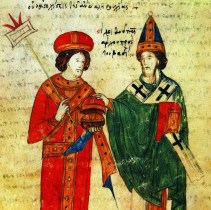- Feb 5, 2002
- 166,280
- 56,021
- Country
- United States
- Faith
- Catholic
- Marital Status
- Married
- Politics
- US-Others
This is my second post exploring the connection of East and West in the Church (with the first focused on Orthodox saints brought into the Catholic Churchthrough the Eastern rites). When looking at the relationship of the Catholic and Orthodox Churches (as distinct from the Oriental Orthodox Churches, which are not treated in this post), we generally point to 1054 as the clear cut date when the two churches split in a great schism. Is 1054, however, a clear line in the sand? The excommunication placed on the altar of Hagia Sophia by Cardinal Humbert Moyenmoutier did not have the entire Orthodox Church in its scope and, furthermore, did not have the force of law, as the Pope Leo IX had died during this diplomatic mission.

Michael Cerularius and Pope Leo IX
1054 captures our imagination, nonetheless, and it is therefore worth exploring the much more detailed narrative of the complicated history East and West that entailed more back and forth both before and after 1054. I’ve been thinking about this for many years, and, even after jotting down some initial notes for this post, I was happy to see two other articles addressing a more complete account of what occurred, trying to give a bigger picture: Nathan Smolin’s helpful overview of the events of 1054 and Charles Yost’s reconsideration of the traditional narrative of the schism. Metropolitan Kallistos Ware also provides important testimony to continuing intercommunion in the early modern period, pointing to a process of growing apart, rather than a single event.
Continued below.
1054? The More Complicated History of East-West Relations

Michael Cerularius and Pope Leo IX
1054 captures our imagination, nonetheless, and it is therefore worth exploring the much more detailed narrative of the complicated history East and West that entailed more back and forth both before and after 1054. I’ve been thinking about this for many years, and, even after jotting down some initial notes for this post, I was happy to see two other articles addressing a more complete account of what occurred, trying to give a bigger picture: Nathan Smolin’s helpful overview of the events of 1054 and Charles Yost’s reconsideration of the traditional narrative of the schism. Metropolitan Kallistos Ware also provides important testimony to continuing intercommunion in the early modern period, pointing to a process of growing apart, rather than a single event.
Continued below.
1054? The More Complicated History of East-West Relations
